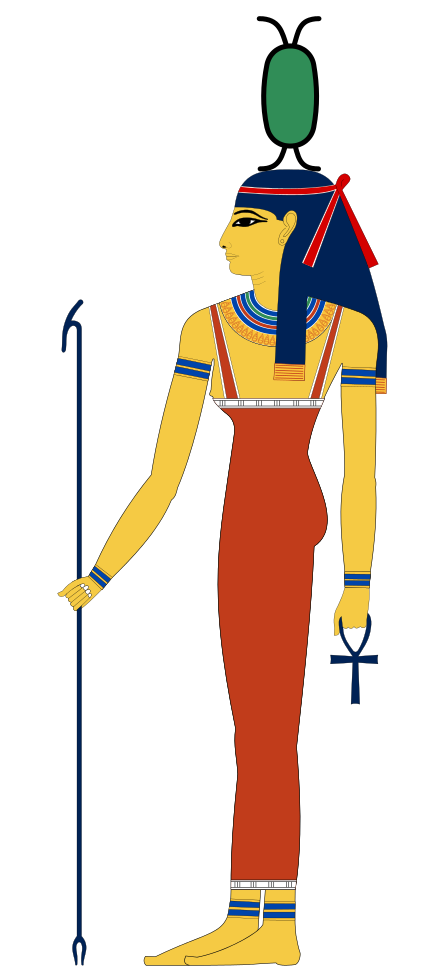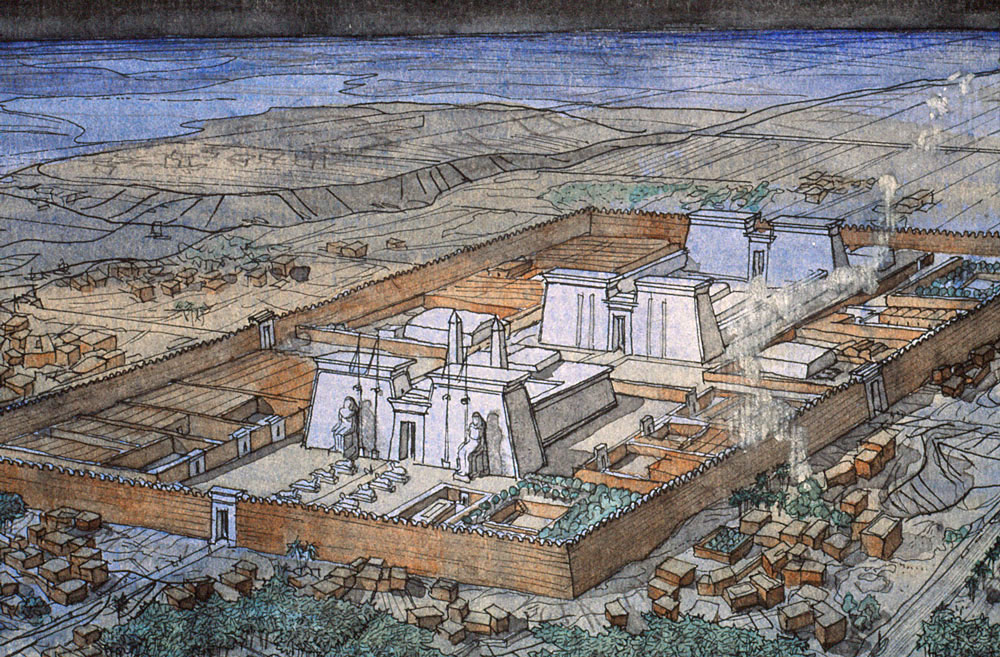Picture above: Temple of sais at night by Jean Claude Golvin
Some millennia ago, in ancient Egypt, the Western Nile Delta on the Canopic branch of the Nile was the location of the ancient and mystic city of Sa, from the Greek name “Sais” (the modern day governorate of Gharbiyah). On the archaeological site of the city, there is a village called Sa-el-Hagar, translating from Arabic into (Sa the stone), which indicates that in this location, there was once an impressive city filled with magnificent stone structures and buildings.
Around 3000 BC when the Pharaonic era was starting, the city was the cult centre of the war goddess and creator, Neith. Neith was the goddess of Sais, a great protector of the people of the land and an accomplished mediator between humanity and the gods. This is quite rare in Egypt because usually, creation gods and deities are males. She is depicted wearing the Deshret red crown (which bears the cobra of Wadjet), of Lower Egypt indicating that she was of great importance to the entire northern region of Egypt. From 1000 BC and onwards, the Neith temple was a centre of pilgrimage.
Some centuries later during the years 664-525 BC, the city was famed as Egypt’s Pharaonic capital and centre for ceremonial events of the 26th Dynasty kings. About 150 years later, the Greek historian, Herodotus described Sais as a great city, filled with grand temples, colossal statues, and splendid royal tombs. He also describes the Sacred Lake at Sais, where rituals were performed and water from the lake was used for washing in the temple of Sais. Herodotus also describes witnessing the ceremony of the Lighted Lamps Festival performed on the lake, where the light lamps were saucers filled with salt and oil with the wick floating thereon and burning all night. The festival was celebrated on the 13th day of the 3rd month of summer in honour of the goddess, Neith.
The ancient city of Sais is renowned of having a medical school that was associated with the temple. The medical school of Sais had many female attendees and participants, both as students and as faculty members, focusing mainly on the fields of gynaecology and obstetrics. A name that has been associated with the temple school of Sais is, Pesehet (2500 BC). She is the second recorded female physician in all of history after Merit-Ptah (2700 BC). It is recorded that Pesehet oversaw the training of the midwives, that fact, along with her given title “Lady Overseer of Female Physicians’ indicate that not only was she a physician but that she was the supervisor of a group of other female physicians. She also held another title, “King’s Associate” and this indicates that she was possibly the personal physician of the monarch. Her advancing in the field of medicine was through teaching it and influencing her society. When taking into account the collected archaeological data, it is concluded that Pesehet is the first woman known to have had a high professional status in an ancient civilization.

An excavation held in 1993 uncovered the location of the capital city of Sais, including an industrial area. They also found Greek trading amphorae and cups and Syro-Palestinian wine jars, which indicate that the city of Sais was actively engaged in trading with the surrounding areas and lands. Upon further searching, objects and material from around 1100 BC were revealed. They indicate that Sais was a wealthy farm town at the time, for houses were found to contain ovens, storerooms, reception rooms and courtyards. Evidence was also found that at the time, they worshiped a local cobra goddess by the name of Wadjet (the same cobra on the Deshret crown of Lower Egypt worn by Neith) .

It is thought that all the kings of Sais were buried in the city; however, their tombs have not been discovered yet. The Egypt Exploration Society is sponsoring a survey and an archaeological assessment of the site. Even though the site currently lacks of things to see, evidences and clues are promising that there is still much to be discovered and secrets waiting to be unravelled in the location of the ancient and royal city of Sais.

